 A Fictional Tale based on personal experiences of American and Australian POWs
A Fictional Tale based on personal experiences of American and Australian POWs
by Marks Hinton
He was born in Sargent, Texas on June 23, 1924. A hurricane was raging outside the two-room wooden shack where, just before midnight, his grandmother slapped his bottom to jump-start the short life of Rulon Allen James, Jr. This would be the first time Rulon was in the wrong place at the wrong time but it would not be the last.
Sargent, a bucolic wide spot on Farm-to-Market road 457, is just six miles from the Gulf of Mexico, somewhere you do not want to be with a category four hurricane about to make landfall at East Matagorda Bay. A U.S. Weather Bureau technician in Galveston received a telegram mentioning a disturbance, little more than a squall, near the West Indies on June 12. Residents of the Texas Gulf coast received his report with disinterest. A major hurricane had not hit the area since the great storm of 1915 tore into Galveston Island. Five days later the winds reached 74 miles per hour, hurricane force. It crashed through Jamaica and Cuba before barreling into the Gulf like a runaway freight train. It didn’t look good – the winds were increasing, the barometric pressure was dropping and the death count was mounting.
As if sent by demonic forces to welcome baby Rulon into the world, the storm took aim on the Texas coast. Sargent was to be ground zero. Although experiencing squalls much of the day, the James family remained unconcerned about the deteriorating meteorological conditions and took no precautions. Instead, Rulon Sr., a dirt-poor sharecropper, wanted to get some cotton in the barn before the rain could hammer the bolls into the muddy field, ruining yet another crop.
The storm struck with its full fury just after sunset. The Weather Bureau classified it as a severe hurricane, with flooding from the storm surge reaching 10 miles inland. As it made landfall at East Matagorda Bay, the surge was 22 feet. Sustained winds were 150 mph with gusts reaching 175. And central pressure dropped to 27.49″. Rainfall totaled 19 inches at Sargent. Eleven tornadoes spun out of the rear portion of the storm. The body count began to rise. Between Galveston and Aransas Pass 34 died, including 22 persons who drowned. Among them were Rulon Allen James Sr. and his wife, Loretta Mae.
 The storm surge crashed into the James shack, knocking the flimsy structure off its concrete block pilings. The building careened around in the swirling waters until finally smashing into the only brick building in Sargent, Bullard’s Grocery and Bait Shop. The force of the blow shattered the house and scattered the inhabitants. Rulon Sr. and Loretta were washed away into the darkness. Grandma James, who was holding the baby, grabbed the rear door of the shack that had been knocked off its hinges to use as a raft. The old woman and the newborn had not run out of luck. As the eye passed over Sargent, she paddled to Bullard’s, climbed in a second story window and rode the storm out with the newborn baby clutched to her breast. Rulon was not yet a day old and he was an orphan.
The storm surge crashed into the James shack, knocking the flimsy structure off its concrete block pilings. The building careened around in the swirling waters until finally smashing into the only brick building in Sargent, Bullard’s Grocery and Bait Shop. The force of the blow shattered the house and scattered the inhabitants. Rulon Sr. and Loretta were washed away into the darkness. Grandma James, who was holding the baby, grabbed the rear door of the shack that had been knocked off its hinges to use as a raft. The old woman and the newborn had not run out of luck. As the eye passed over Sargent, she paddled to Bullard’s, climbed in a second story window and rode the storm out with the newborn baby clutched to her breast. Rulon was not yet a day old and he was an orphan.
***
Rulon’s grandmother rented a rundown shack that miraculously survived the storm. It was now her job to raise the boy. She earned a few dollars taking in washing, sewing, selling vegetables from her modest garden and later, receiving a small pension check from the Social Security Administration. Rulon held odd jobs after school – pumping gas at Bullard’s, mowing lawns and waiting tables in the small greasy spoon cafe old Bull Bullard opened next to the store. His adolescent years were generally uneventful until a U.S. Naval recruiter appeared at Bay City High School, a 30-minute school bus ride from Sargent. It was the summer of 1941, just before graduation. He was 17 years old and it was time to do something with his life.
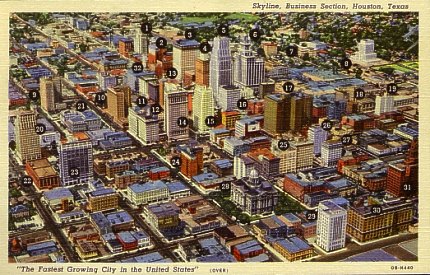 Rulon had never been outside of Matagorda County except for a trip to Houston to visit a distant cousin when he was 15. Houston was a booming oil town. It had everything Sargent lacked– pretty girls, motion picture palaces, drive-in restaurants, zoo, swimming pools, the Houston Buffalos Texas League baseball team and Rettig’s Ice Cream Parlor. It looked like paradise to a poor sharecropper’s son.
Rulon had never been outside of Matagorda County except for a trip to Houston to visit a distant cousin when he was 15. Houston was a booming oil town. It had everything Sargent lacked– pretty girls, motion picture palaces, drive-in restaurants, zoo, swimming pools, the Houston Buffalos Texas League baseball team and Rettig’s Ice Cream Parlor. It looked like paradise to a poor sharecropper’s son.
He never knew if he enlisted to “join the Navy and see the world,” to fight for his country in some exotic land or just to get out of Sargent. It didn’t matter. A week after graduation he kissed his grandmother good-bye, promising to write often, hopped a Greyhound bus to Houston and boarded the Southern Pacific’s Sunset Limited for San Diego where he was to report for basic training. As the train pulled out of the station he said to himself, “I think I’ll come back here when my hitch is up. Houston is my kind of town.”
***
After basic he requested and was granted permission to serve as a gunner’s mate on the U.S.S. Houston. He chose that ship solely because of the name. She would soon put Rulon in the wrong place at the wrong time for the second time in his young life.
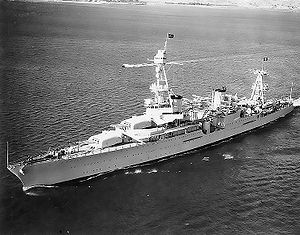
USS Houston
The USS Houston, a 9,050-ton Northampton class light cruiser, was built at Newport News, Virginia. Commissioned in June 1930 and reclassified as a heavy cruiser a year later, she initially was assigned the Atlantic and Gulf of Mexico. Early in 1931 she steamed into the Pacific and was commissioned flagship of the Asiatic Fleet. Following that tour of duty, the Houston was deployed in exercises that tested the Navy’s readiness for war. In addition, she transported President Franklin D. Roosevelt several times between 1934 and 1939.
Rulon’s orders sent him to the Philippines in the fall of 1941 where the U.S.S. Houston was once again serving as flagship of the Asiatic Fleet. Then came December 7, 1941 and the sneak attack on the U. S. fleet at Pearl Harbor. It was war. She was immediately dispatched to patrol the islands of the Australian and Netherlands East Indies. As the only heavy cruiser in those waters, she saw considerable action as the Japanese launched heavy attacks on those islands. On February 4, 1942 the Houston took a direct hit on her gun turret rendering it inoperable. Nonetheless, she remained in that theater of combat and participated in the Battle of the Java Sea on February 27. As the situation deteriorated the Houston and the H.M.A.S. Perth, a British light cruiser, were ordered to return to Java. That night the two ships encountered one of the largest Japanese task forces of the war, 4 cruisers and 13 destroyers. Despite a valiant fight against overwhelming odds and firepower, both ships were sunk. The “Galloping Ghost of the Java Coast” as the Houston was affectionately known, slipped below the waves at 12:30 AM on February 28, 1942. Out of a crew of 1015, 655 men died with her. Rulon was not one of them. He was among the less fortunate 360 sailors and officers who were captured. Rulon was plucked out of the shark-filled waters by seamen on the Japanese cruiser Mikuma. He was now a prisoner-of-war.
***
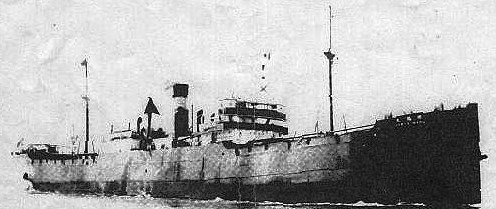
Junyo Maru
He did not know it yet, but he was on his way to the worst place in the world. Once again Rulon’s curse of being in the wrong place at the wrong time struck – this time with a vengeance. The Mikuma steamed to Java where the prisoners were incarcerated in a POW camp known as “Bicycle.” Their stay was short-lived, as the Japanese transport ship Junyo Maru was quickly dispatched to transport this valuable cargo of slave labor to Singapore. The Japanese High Command needed a land route from Siam (Thailand) to Burma to support troops in that latter theater as the sea lanes through the Straits of Malacca had become extremely vulnerable to Allied submarines. They knew the British had surveyed the area prior to the War to evaluate the feasibility of constructing a narrow gauge railroad line. However, the English quickly decided the project was virtually impossible considering the terrain. They also lacked one asset the Japanese now had plenty of – slaves. Three weeks after the sinking of the Houston, Rulon and his companions were marched down the gangplank of the Junyo Maru. They were headed to Singapore’s notorious Changi Prisoner of War camp to join thousands of British and Australian prisoners.
The Japanese High Command demanded construction start on the rail line immediately. So on June 18, 1942 Rulon and 7,500 other POWs were again marched to Singapore’s port. They were stuffed into the stinking, sweltering heat of the Junyo Maru’s hold for a short trip up the Gulf of Siam to Bangkok. Others were transported to Burma. The Japanese engineers decided the fastest way to complete the project was to build from the ends to the middle. From Bangkok, under the watchful eye of the troops of the Imperial Army of Japan, the prisoners were force-marched 25 miles west to Ratchburi province to begin construction on the infamous Nong Pladuk to Thanbyuzayat Railroad. Rulon was among the first prisoners to arrive. It was June 23, his 18th birthday.

Construction of the original rail line, 1942
It wasn’t long before the Japanese had amassed 30,000 British, 18,000 Dutch, 13,000 Australian and 700 American POWs to commence this enormous project. British engineers had estimated construction would take five years. Under the harsh eye of the Japanese engineers with a huge pool of slave labor, the railroad was completed in 17 months – but not without an incredible loss of life.
The first phase of the project was to erect three POW camps – at Kanchanaburi and Ban Pong, Siam and Thanbyuzayat, Burma. The general rule along the route was to first construct quarters for the Japanese prison guards, followed by a kitchen, huts for the prisoners and finally a rudimentary infirmary.
Rulon was assigned to the Chong Kai camp near Kanchanaburi. He was lucky to be among the first to arrive. He received a full mess kit from his captors – loincloth, hat, boots, tin plate and spoon, water bottle, ground sheet, blanket and a rather worn mosquito net. POWs who arrived later were forced to get by with considerably less.
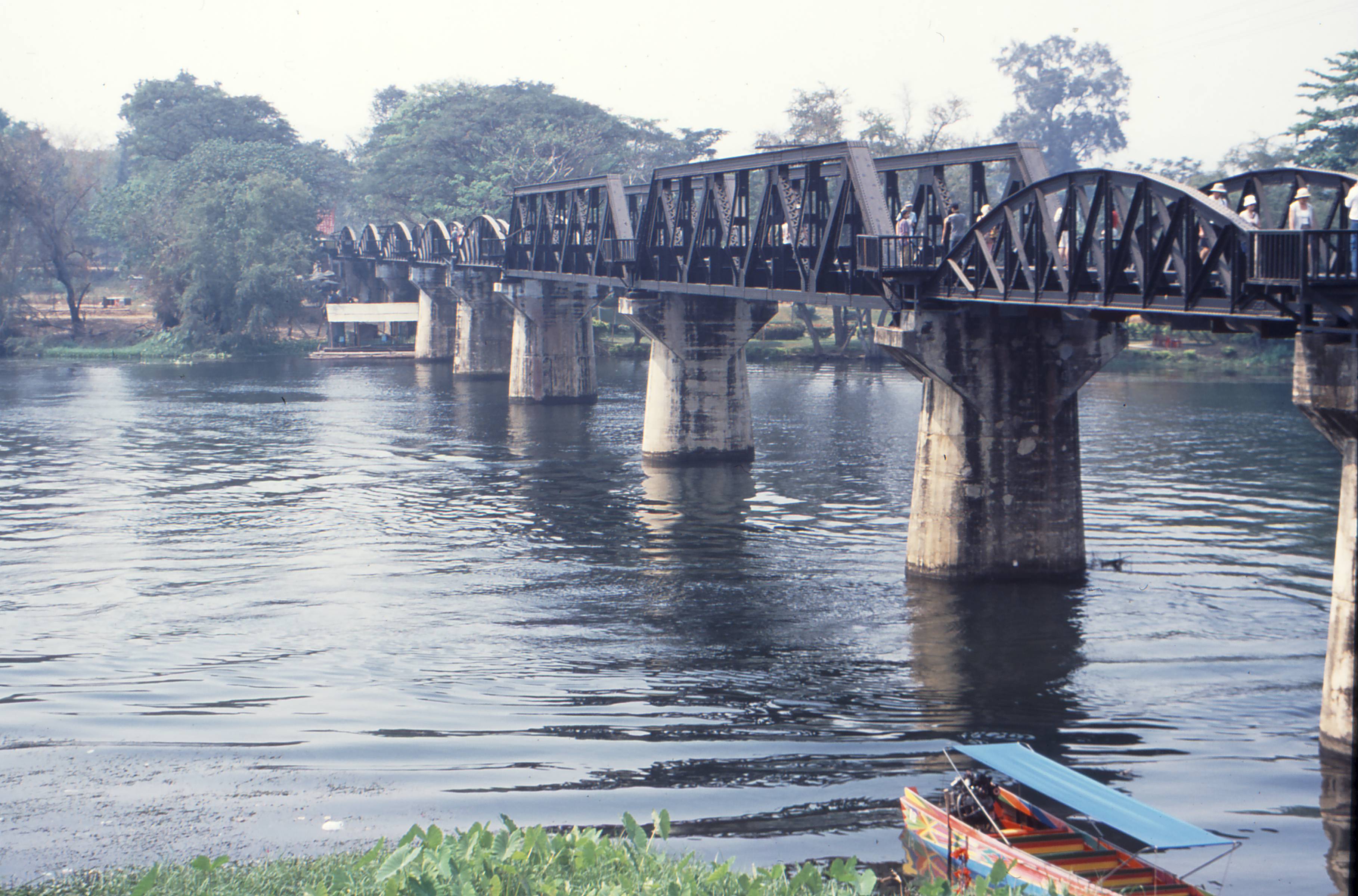
Reconstructed Bridge over Kwae Yai River
The Kwae Yai River, a slow moving ribbon of green, flows through Kanchanaburi and was the first of many obstacles the engineers and prisoners would face over the next hellacious months. Many years later the world would come to know this place well. A novel by Pierre Boulle and an Academy Award winning motion picture, The Bridge on the River Kwai, would tell the story.
The first 35 miles of the rail bed was deceivingly easy to build because of the level terrain. It was for the next 222 miles that it earned its name – “The Death Railway.”
Rulon found life in the prison camp not too unpleasant at first. The laborers could supplement their rations with foodstuffs by bartering with Siamese families. Bananas, papayas and melons were readily available. In addition, the locals would often smuggle tobacco and medicine to the prisoners. He still weighed over 200 pounds and was in excellent health. All of that would change.
As 1942 wore on the situation inevitably deteriorated. Illness increased, causing fewer men to shoulder the burden of building the bridge and rail line. The project was falling behind schedule. The High Command was furious. A new plan was instituted called “Speedo.” The Law of Unintended Consequences came into play: ill and malnourished prisoners were forced to work longer hours on reduced rations and rest and the death count began to climb dramatically, slowing progress even more.
By the monsoon season of early 1943 the project was a hellish nightmare. Rations were cut to one meal a day of maggot-filled rice, rotting salted vegetables and unsanitary water. This diseased petri dish, overflowed with disastrous results. Epidemics swept through the camps like some biblical plague. At first it was just amoebic dysentery, now referred to as “turista,” relatively benign and easily treatable. But before long it became shigellosis, a highly contagious and severe form of diarrhea transmitted by contaminated water and fomites such as latrine seats, clothing, etc. Next came cholera, a deadly and extremely communicable disease of the intestinal tract that can easily lead to death under the unsanitary conditions and lack of medical care that existed along the “Death Railway.” The victim first experiences diarrhea, followed by severe abdominal cramps, nausea and vomiting. Eventually the loss of fluids is so great, death comes from almost total dehydration and a shutdown of the body’s operating system. Somehow Rulon contracted neither of these diseases. The demons of the jungle had something much worse in mind for him – malaria. The Anopheles mosquito, an insect often encountered in the sweltering jungles of Southeast Asia, carries this tropical disease. Malaria’s symptoms include high fever, uncontrollable shivering, bone breaking joint pains, vomiting, convulsions and if not treated, coma and death. In addition, it is incurable, so it will go into remission only to surface again. Just prior to the bridge’s completion in February 1943, Rulon collapsed and was taken to the infirmary to die. That probably would have been for the better, but a villager had smuggled a small supply of quinine into Chong Kai and his now hellish life was prolonged.
As the prisoners died or fell ill, the Japanese guards dramatically increased the maltreatment of the few still capable of working, accusing them of deliberately sabotaging the schedule. Sadism was the order of the day. Men were savagely beaten with sliced bamboo poles causing huge welts and pulling skin off in chunks. Others were tied to trees with barbed wire and left in the sun for days without food or water. Rulon was discharged from the infirmary, but in his weakened condition he was not able to work as diligently as before. Particularly sadistic guards made him kneel on sharp bamboo stakes for three hours while holding a large boulder on his shoulders. The pain was beyond comprehension and he was never able to walk normally again.
As the supply of able-bodied POWs fell, the captors impressed more than 200,000 Asians as coolies to get the project back on schedule. These Malays, Tamils, Chinese and Burmese met fates worse that the prisoners. They were treated less humanely than the POWs, as the Japanese considered them a subhuman form of life. An estimated 150,000 perished in the months it took to finish the “Death Railway.”
***
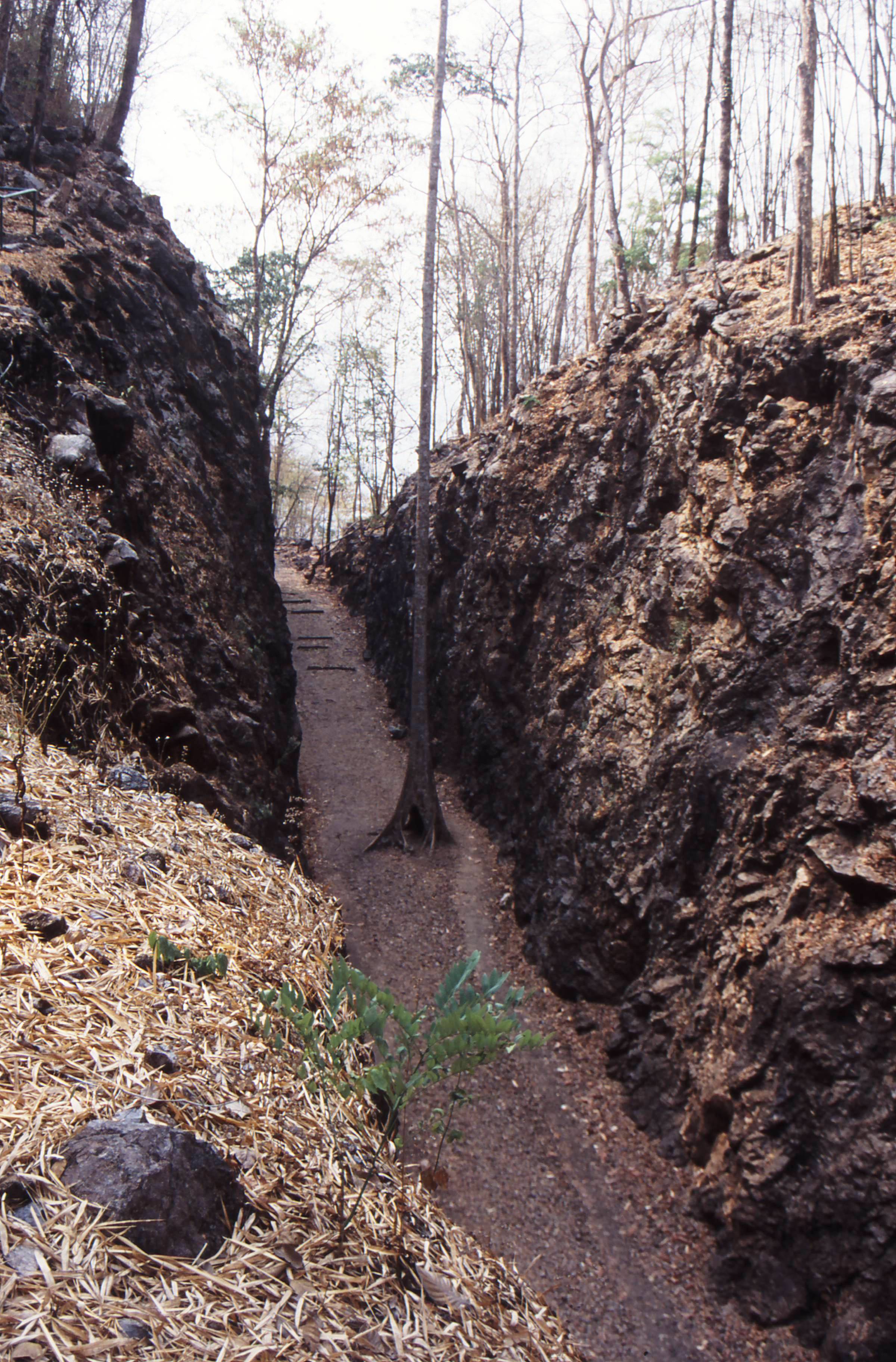
Hellfire Pass
One of the most difficult sections of this most difficult project became known as “Hellfire Pass.” Because Japanese locomotives were underpowered, they were incapable of climbing anything greater than a slight grade. If the locomotive couldn’t go over it, it was the prisoners’ burden to tunnel through it. North of Kanchanaburi a huge rock formation, miles long, had been thrust up in some prehistoric geologic upheaval and intersected the railroad’s proposed path. The southern portion could not be joined with the one coming down from Thanbyuzayat unless this barrier could be breached. An already fiendish situation was about to get worse for an ill-fated group of Australians, New Zealanders and a handful of American POWs including the now malarial, severely crippled and malnourished — his weight had fallen to 118 pounds — Rulon Allen James, Jr. Few of these men had ever heard of Dante Alighieri but it would not be long before each of them could write their own version of The Inferno, with tales that would make the poet cringe with horror.
Their increasingly sadistic captors put the first 400 prisoners to work on April 25, 1943. Ironically it was ANZAC day back in New Zealand, a memorial holiday honoring the men and women who died in the horrific siege of Gallipoli during World War I. The atrocities never change.
Once again Rulon found himself in the wrong place at the wrong time He was transferred here because his limited ability to walk and recurrent bouts of malaria greatly reduced his value for laying railroad ties or swinging a sledgehammer to pound in iron spikes. However, he could sit in place with a chisel and chip away at the mass of rock allowing him to receive two small rations of food and water daily. By now the fiendish Japanese commander, Major Mizandi, had begun starving the sick prisoners to nourish the few that could work. He proudly named his new policy “No work, no food!”
Prisoners worked 18 hours a day, chipping rock with picks, hammers or just picking away small bits with their bloody fingers. The engineers managed to acquire several antique mining drills that made progress a bit faster but the rock bits constantly shattered. A limited amount of blasting powder was available. The project operated around the clock. Oil rag fires burned at night in the deepening crevasse prompting the prisoners to imagine what the fires of Hell might look like, resulting in the name of this Godforsaken place.
The ridge was finally penetrated in early October. Hellfire Pass was open, but the cost was high – 2710 Australians, 5 New Zealanders and an unknown number of Rulon’s fellow American prisoners had perished in the six months it took to breech the mountain. Rulon survived only to suffer more atrocities over the next almost two years of his captivity.
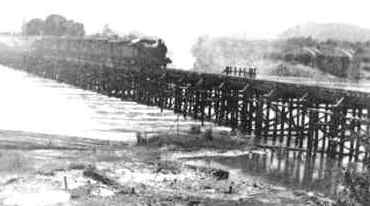
Japanese crossing the bridge, 1943
Later that month the Japanese drove a ceremonial spike in a rail tie south of Three Pagoda Pass indicating the completion of “Death Railway.” It began to carry traffic on October 25, 1943. Over 16,000 Allied prisoners died in its construction, 62 for every mile the railroad traverses.
Six prison camps with 30,000 prisoners were kept open following completion of the project in order to maintain the rail line. Although the backbreaking work was over, the death toll continued to rise. Malnourishment remained a serious problem, as did epidemics of dysentery, malaria and cholera. Others died in Allied bombing raids as the Japanese placed the camps almost on the railroad right-of-way: “killed by friendly fire” as they say in the military. The remaining captives were dispersed to work camps and factories in Bangkok, Saigon, Singapore and the homeland of Japan. The crippled Rulon was among them.
***
He arrived in Bangkok in early 1944. There he was sent to a textile factory where a captured English tailor taught him how to operate a pedal-powered sewing machine. Rulon quickly mastered the art and was soon turning out uniforms for the Imperial Army. For the first time since his initial incarceration at Chong Kai, living conditions were bearable. The guards at the facility seldom abused the prisoners. He received a modest serving of rice and fish three times daily along with unlimited amounts of hot tea to wash it down. Periodically he was able to secure a few vegetables to add to the mix. His cot came with a light blanket. His health improved moderately.
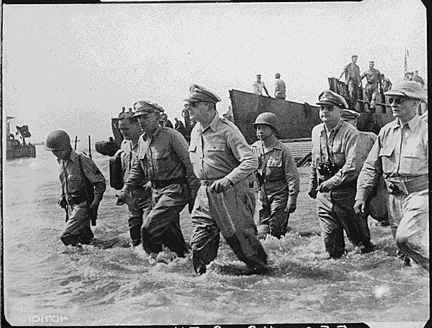
McArthur liberating the Philippines
What Rulon did not know was the tide of the Pacific Campaign had turned in the Allies’ favor. On August 1, 1944 General Douglas MacArthur’s forces reached the northern coast of New Guinea, placing them just 600 miles south of their principal objective – the Philippines. The invasion began October 20 with the Battle of Leyte Gulf. Here the U. S. 7th Fleet hit the Japanese hard, sinking three battleships, four aircraft carriers, ten cruisers and nine destroyers. The Empire was staggering. On January 9, 1945 MacArthur landed on the island of Luzon forcing the enemy to fall back on Manila. The capitol of the Philippines was liberated on February 24. Now facing only pockets of resistance, MacArthur turned his attention toward Borneo and Malaya. He dispatched Australian and Dutch troops to expel the Japanese and ordered them to proceed up the Malaya peninsula to capture Bangkok. Simultaneously, the British were routing the Imperial Army out of Burma and approaching Siam from the north. It was only a matter of time before Southeast Asia would be liberated.
Sensing it was time to prepare for one last stand to defend the homeland, the Japanese High Command ordered all prisoners shipped to Japan where they could produce goods for the flagging war effort. In the last week of July, Rulon and 6,500 other POWs were taken to a dock on Bangkok’s Chao Phraya River and crammed into the hellish hold of the Tokyo Maru, a 5,065-ton coastal freighter, for the two-week transshipment to Japan. It did not take long for the situation to turn deadly. The combination of extreme heat, lack of food and water, dehydration and a total absence of sanitary conditions produced a cesspool of degradation. Two hundred men a day were dying. An estimated 2,800 would never set foot on dry land again. Rulon miraculously survived. The Goddess Fortuna had one additional bad roll of the dice awaiting him.
***
It was pitch black and the freighter’s engines stopped their relentless throbbing. Rulon knew they had arrived at their destination. The holds were opened and the POWs ordered to disembark. He could tell in the faint glow of the morning the Tokyo Maru had docked in a large port. There were hundreds of other vessels at the piers or in anchorage. He was marched to a waiting freight train and stuffed into a slatted wooden railroad car. Rulon was lucky that he had secured a spot where he could see through the slats as well as breathe fresh air for the first time in 14 days. He had no way of knowing but this was going to be the last time he was in the wrong place at the wrong time.
The sun was now up, revealing a blue sky with high-scattered clouds. It was just after 8:00 AM on August 6, 1945 when the train began to chug slowly out of the port toward the city. Rulon noticed a signpost in Japanese that he guessed identified the place. It meant nothing to him. In his mind it was just another slave labor camp.
***
At 8:15 Fortuna closed her book on the short, ill-fated life of Rulon Allen James Jr. with the arrival in the skies over Hiroshima of a Boeing B-29 named Enola Gay with its deadly cargo, nicknamed “Little Boy.”
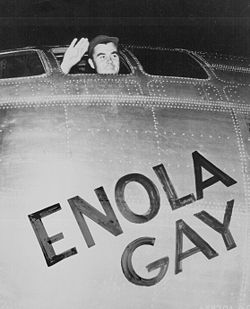
Captain Paul Tebbets on the way to Hiroshima
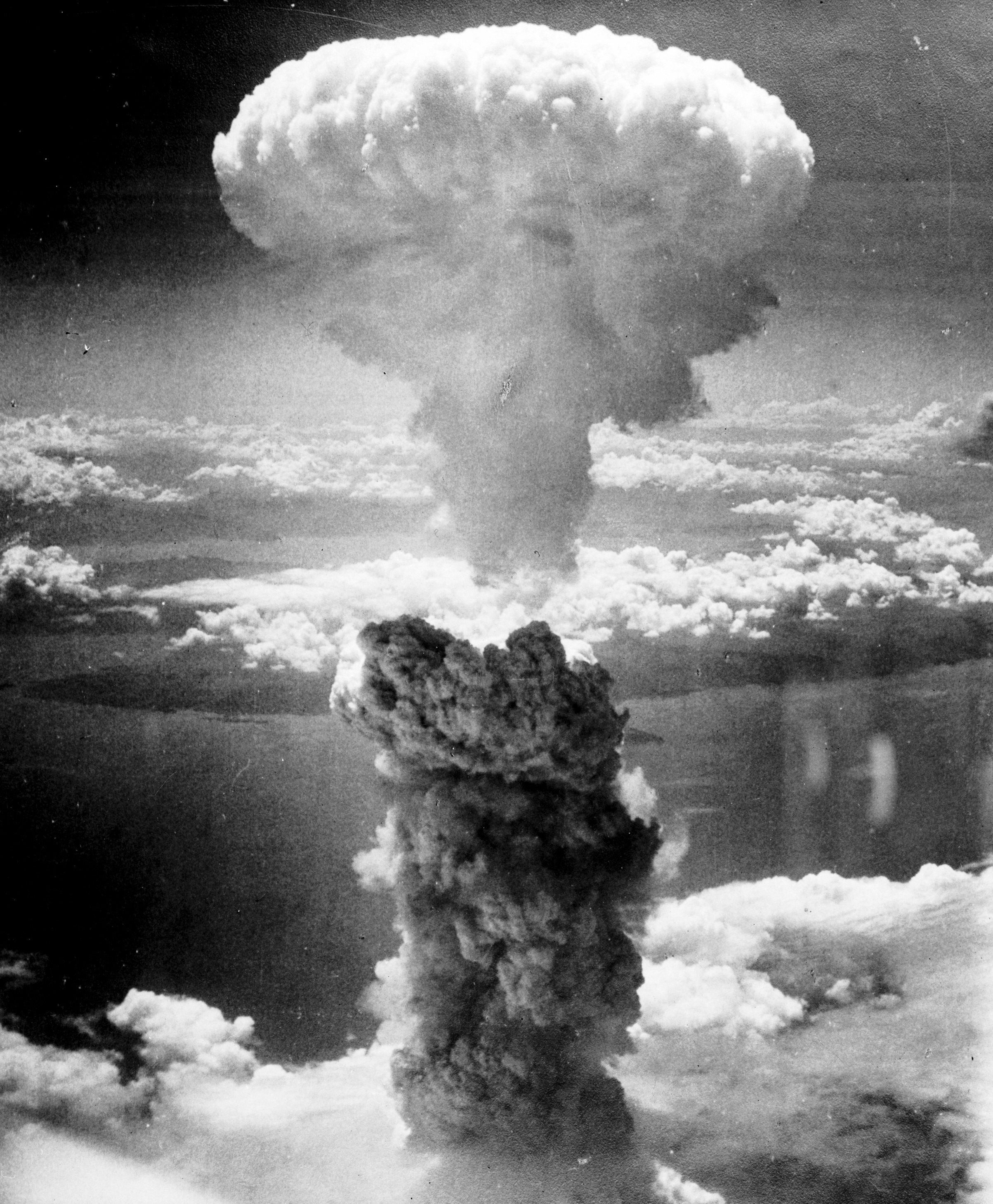
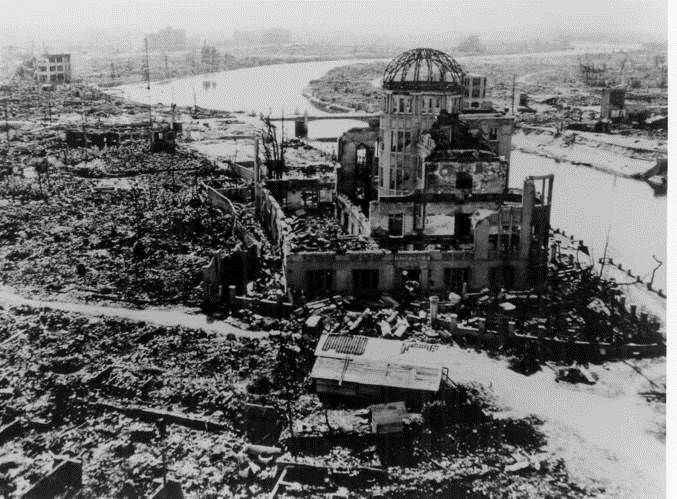
Hiroshima after the bomb
The End

